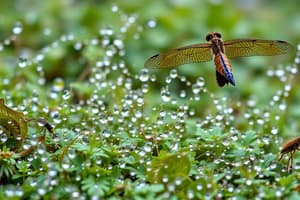Podcast
Questions and Answers
Which factor deals with the maximum population size an environment can sustain?
Which factor deals with the maximum population size an environment can sustain?
- Inter-specific competition
- Carrying capacity (correct)
- Density dependent factors
- Habitat and niche
In a food chain, what is the primary source of energy?
In a food chain, what is the primary source of energy?
- Predator-prey relationships
- Density independent factors
- Abiotic factors (correct)
- Parasitism
What type of relationship involves one organism benefiting while the other is harmed?
What type of relationship involves one organism benefiting while the other is harmed?
- Commensalism
- Parasitism (correct)
- Predator-prey relationships
- Mutualism
Which term describes the interactions between individuals of the same species competing for resources?
Which term describes the interactions between individuals of the same species competing for resources?
What is the main reason for energy loss as you move up trophic levels in an energy pyramid?
What is the main reason for energy loss as you move up trophic levels in an energy pyramid?
What is the term for the relationship in which one species benefits while the other is unaffected?
What is the term for the relationship in which one species benefits while the other is unaffected?
Which factor influences population growth regardless of the population's size?
Which factor influences population growth regardless of the population's size?
What term describes the role an organism plays in its ecosystem?
What term describes the role an organism plays in its ecosystem?
In an energy pyramid, which level of consumers would typically have the lowest energy available to them?
In an energy pyramid, which level of consumers would typically have the lowest energy available to them?
What type of competition occurs between individuals of different species?
What type of competition occurs between individuals of different species?
Flashcards are hidden until you start studying
Study Notes
Population and Community
- A population is a group of individuals of the same species living in a specific geographic area
- A community is a group of different species living in a specific geographic area
Abiotic vs. Biotic Factors
- Abiotic factors: non-living components of an ecosystem (e.g. light, temperature, water, soil)
- Biotic factors: living components of an ecosystem (e.g. plants, animals, microorganisms)
Predator-Prey Relationships
- Predators: organisms that hunt and feed on other organisms
- Prey: organisms that are hunted and fed upon by predators
- Predator-prey relationships can be affected by factors such as population density and habitat
Habitat and Niche
- Habitat: the natural environment in which an organism lives
- Niche: the specific role and position of an organism within its habitat
- Niche includes factors such as food, shelter, and breeding grounds
Carrying Capacity
- Carrying capacity: the maximum number of individuals of a species that an ecosystem can support
- Factors affecting carrying capacity: food availability, water, shelter, disease, and predation
Density Dependent vs. Independent Factors
- Density-dependent factors: factors that affect population growth rate depending on population density (e.g. disease, predation)
- Density-independent factors: factors that affect population growth rate regardless of population density (e.g. natural disasters, climate change)
Inter and Intra Specific Competition
- Intraspecific competition: competition between individuals of the same species
- Interspecific competition: competition between individuals of different species
- Competition can be for resources such as food, water, and shelter
Parasitism, Mutualism, and Commensalism
- Parasitism: a relationship in which one organism benefits and the other is harmed
- Mutualism: a relationship in which both organisms benefit
- Commensalism: a relationship in which one organism benefits and the other is not affected
Food Chains, Food Webs, and Energy Pyramid
- Food chain: a series of organisms that eat other organisms, with each level representing a trophic level
- Food web: a network of food chains that are interconnected
- Energy pyramid: a diagram representing the flow of energy from one trophic level to the next
- Energy is lost as you go along trophic levels due to metabolic processes, heat, and waste
Studying That Suits You
Use AI to generate personalized quizzes and flashcards to suit your learning preferences.




